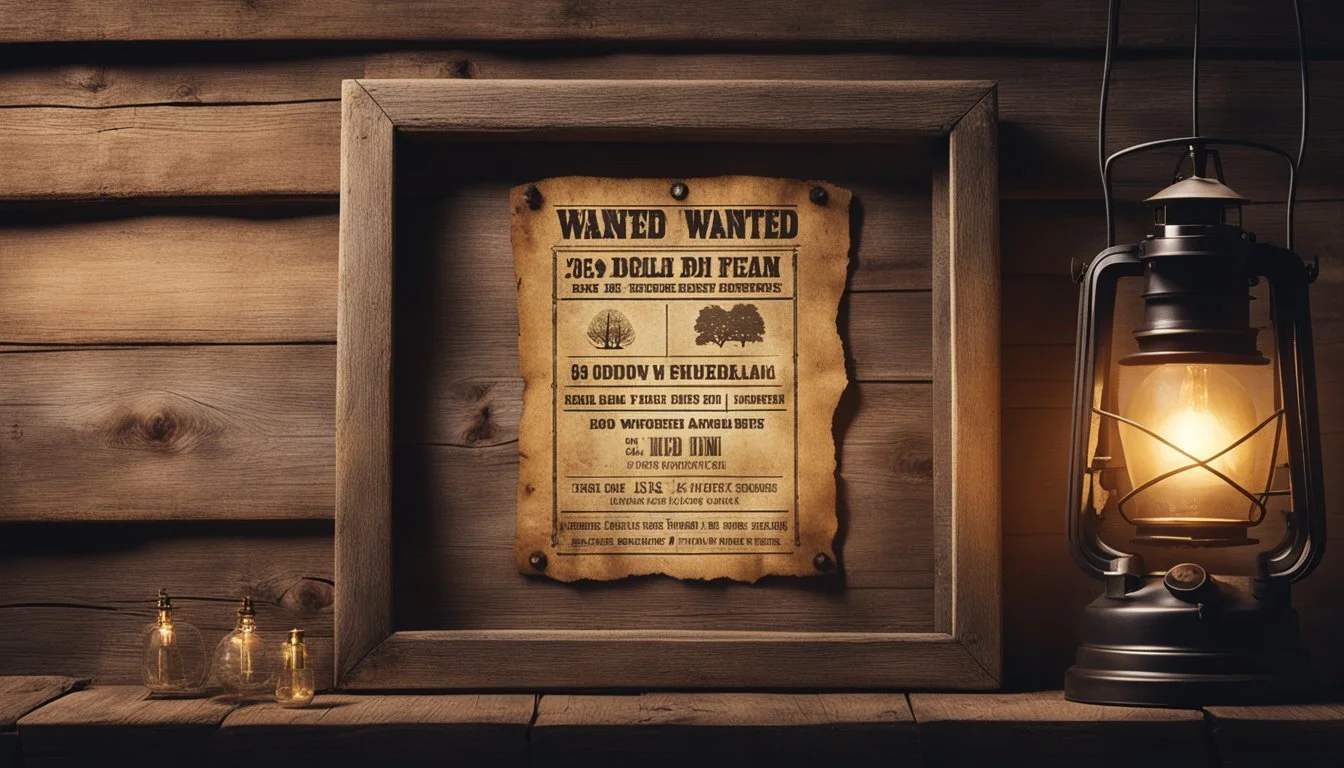5 Belle Starr Documentaries That Uncover the Queen of Outlaws
Exploring the Life of a Legendary Wild West Figure
Belle Starr, known as the "Bandit Queen" of the Wild West, left an indelible mark on American frontier history. Her life of crime and association with notorious outlaws have captivated audiences for generations. From her early days in Missouri to her untimely death in Oklahoma Territory, Starr's story is filled with intrigue and adventure.
Several documentaries have sought to uncover the truth behind Belle Starr's legendary status and separate fact from fiction. These films delve into her relationships with famous outlaws, her own criminal activities, and the circumstances surrounding her unsolved murder. By examining historical records and expert analysis, these documentaries provide viewers with a deeper understanding of this complex figure from the American West.
1) 'Belle Starr: Queen of the Oklahoma Outlaws' by author Glenn Shirley (1952)
Glenn Shirley's book 'Belle Starr: Queen of the Oklahoma Outlaws' offers a comprehensive look at the life of the infamous outlaw. Published in 1952, this work stands as one of the earliest detailed accounts of Belle Starr's exploits.
Shirley, a respected historian and author, meticulously researched Belle's life, separating fact from fiction. He explores her origins in Missouri and her transformation from Myra Maybelle Shirley to the notorious Belle Starr.
The book delves into Belle's associations with various outlaws, including the James-Younger Gang. It also examines her marriages to Jim Reed and Sam Starr, both of whom were involved in criminal activities.
Shirley's work provides insight into Belle's convictions, including her 1883 horse theft charge. The author paints a complex picture of a woman who straddled the line between law-abiding citizen and outlaw.
The book concludes with an examination of Belle's mysterious murder in 1889, presenting various theories about her untimely demise. Shirley's work remains a valuable resource for those interested in Belle Starr's life and the broader context of outlaws in the American West.
More information about Belle Starr
2) 'Belle Starr and Her Times: The Literature, the Facts, and the Legends' by Glenn Shirley (1982)
Glenn Shirley's book offers a comprehensive examination of Belle Starr's life, separating fact from fiction. The author meticulously sifts through various myths and legends to uncover the truth about the infamous "Bandit Queen."
Shirley presents a nuanced portrait of Belle Starr, highlighting her love for horses, music, and the outdoors. The book also explores her connections to some of the most notorious outlaws of her era.
Despite her reputation, Shirley reveals that Belle Starr was never convicted of any crime more serious than horse thievery. This insight challenges the popular image of her as a hardened criminal.
The author's writing style is both informative and engaging, making complex historical information accessible to readers. Shirley's work is considered one of the most accurate biographies of Belle Starr to date.
'Belle Starr and Her Times' provides a balanced view of its subject, examining multiple perspectives on her life and legacy. It serves as a valuable resource for those interested in separating the real Belle Starr from her mythical persona.
More information on 'Belle Starr and Her Times'
3) 'American Experience: The Wild West' – Episode on Belle Starr (2001)
'American Experience: The Wild West' dedicates an episode to the life of Belle Starr. This PBS documentary series explores the myths and realities surrounding the notorious female outlaw.
The episode delves into Belle's upbringing in Missouri and her transformation from a well-educated young woman to a notorious criminal. It examines her marriages to outlaws Jim Reed and Sam Starr, which played pivotal roles in shaping her infamous reputation.
The documentary uses expert interviews and historical reenactments to paint a vivid picture of Belle's exploits. It covers her involvement in horse theft, bootlegging, and harboring fugitives.
The episode also explores Belle's complex relationships with law enforcement and her eventual demise. It offers a balanced perspective on her life, separating fact from fiction in the legend of the "Bandit Queen."
More information on 'American Experience: The Wild West'
4) 'Outlaw Queen: The Life and Times of Belle Starr' by Burton Rascoe (1941)
Burton Rascoe's book "Belle Starr: 'The Bandit Queen'" offers a comprehensive look at the infamous outlaw's life. Published in 1941, this work provides readers with a detailed account of Belle Starr's exploits in the American West.
Rascoe delves into Starr's associations with notorious criminal groups like the James-Younger Gang. He examines her relationships with other outlaws and her eventual conviction for horse theft in 1883.
The book explores Starr's early life as Myra Maybelle Shirley and her transformation into the legendary "Bandit Queen." It covers her marriages, including her union with Sam Starr, which led to her arrest for horse theft.
Rascoe's work draws on historical records and contemporary accounts to paint a vivid picture of Belle Starr's life and times. It remains a significant resource for those interested in the mythology and reality of this iconic Old West figure.
More information on Belle Starr
5) 'The True Story of Belle Starr' - A documentary film by Wild West History Association (2015)
This documentary offers a balanced perspective on Belle Starr's life, separating fact from fiction. It features interviews with historians and experts on the American Old West.
The film explores Starr's upbringing in Missouri and her transformation into an outlaw. It examines her relationships with various criminals, including members of the James-Younger Gang.
'The True Story of Belle Starr' delves into her marriages to outlaws Jim Reed, Bruce Younger, and Sam Starr. It also covers her 1883 conviction for horse theft and subsequent imprisonment.
The documentary concludes with an analysis of Starr's mysterious death in 1889. It presents different theories about her unsolved murder and examines her lasting legacy as a female outlaw.
Through archival footage and expert commentary, this film provides a comprehensive look at Belle Starr's life and her place in Wild West history.
More information on Belle Starr
Historical Context
Belle Starr's life unfolded during a turbulent period in American history. The Wild West era and changing roles for women shaped the environment in which she became an outlaw.
The Wild West Era
The American frontier in the late 19th century was a lawless landscape. Outlaws thrived in remote areas beyond the reach of law enforcement. Train and bank robberies were common crimes.
The James-Younger Gang, with whom Belle Starr associated, gained notoriety during this time. They exploited the lack of centralized policing to carry out daring heists across multiple states.
Belle Starr's criminal activities coincided with the expansion of railroads and telegraph lines. These technological advancements gradually brought more law and order to the frontier.
The Role of Women Outlaws
Women like Belle Starr challenged traditional gender roles in the Wild West. Most women were expected to be wives and mothers, not criminals.
Belle Starr stood out by wearing men's clothing and riding astride her horse. She gained a reputation for her marksmanship and horse theft.
Other female outlaws of the era included Pearl Hart and Laura Bullion. These women often partnered with male outlaws and participated in robberies and other crimes.
The media sensationalized female outlaws, contributing to their legendary status. Belle Starr's image as the "Bandit Queen" captured the public imagination long after her death.
Belle Starr's Early Life
Myra Maybelle Shirley, better known as Belle Starr, was born on February 5, 1848, in Carthage, Missouri. Her early years were marked by a mix of privilege and turbulence that would shape her future as an infamous outlaw.
Family Background
Belle Starr came from a well-to-do Southern family. Her father, John Shirley, was a successful innkeeper and farmer. Her mother, Elizabeth "Eliza" Pennington, came from a respected family. The Shirleys owned slaves and were considered part of the local elite in Carthage.
Belle was the fifth of eight children. Her older brother, John Addison "Bud" Shirley, would later join Confederate guerrillas during the Civil War. This family connection to outlaws would influence Belle's future associations.
Formative Years
Belle received a quality education unusual for girls of her time. She attended the Carthage Female Academy, where she excelled in music and classical studies. Her piano skills were particularly noted.
The Civil War disrupted Belle's privileged upbringing. In 1864, Union troops burned Carthage, forcing the Shirley family to flee to Scyene, Texas. This upheaval exposed Belle to a rougher frontier life.
In Texas, Belle began associating with outlaws. She became involved with Jim Reed, a former Confederate soldier turned criminal. They married in 1866 when Belle was 18, marking her entry into the outlaw world.
Criminal Activities
Belle Starr engaged in various illegal activities throughout her life, gaining notoriety as an outlaw in the American West. Her criminal pursuits included horse theft, harboring fugitives, and alleged involvement in robberies.
Association with Jesse James
Belle Starr's connection to Jesse James and his gang marked a significant period in her outlaw career. She met Jesse James and the Younger brothers in Missouri during the 1860s. Starr provided shelter and supplies to these notorious outlaws at her home, aiding their criminal operations. Her association with the James-Younger Gang exposed her to more serious criminal activities beyond petty theft.
Starr's involvement with the gang remained mostly supportive rather than directly participatory in their major heists. She acted as an informant and facilitator, helping the outlaws evade law enforcement. This relationship solidified her reputation as a criminal figure in her own right.
Notorious Heists
While Belle Starr's direct involvement in major robberies remains disputed, she was implicated in several high-profile crimes. In 1882, she was arrested for horse theft, a common offense in her criminal repertoire. Starr served nine months in prison for this crime.
Her farm on the Canadian River in present-day Oklahoma became a known hideout for fugitives. In 1886, authorities arrested Starr and her husband Sam for stealing horses and harboring criminals. Though specific details of her participation in robberies are scarce, her repeated arrests and associations with wanted outlaws fueled her infamous reputation.
Starr's criminal activities extended beyond theft to include bootlegging and operating illegal saloons. These enterprises contributed to her image as the "Bandit Queen" of the Wild West.
Legacy and Cultural Impact
Belle Starr's life and exploits have captivated the public imagination for over a century. Her legacy as the "Bandit Queen" continues to influence popular culture and spark historical debates.
Representation in Popular Media
Belle Starr's story has been featured in numerous films, books, and television shows. The 1941 Western film "Belle Starr" starring Gene Tierney romanticized her life as an outlaw. Several documentaries have explored her complex character and criminal activities.
Country music has also embraced Belle Starr's legend. The song "Belle Starr" by Woody Guthrie immortalized her in folk music. Her image as a female outlaw in the male-dominated Wild West has made her an intriguing subject for writers and filmmakers.
Historiographical Debates
Historians continue to debate Belle Starr's true role in criminal activities. Some argue she was more of a minor accomplice than a mastermind. Others maintain she actively participated in horse theft and harboring fugitives.
Recent scholarship has focused on separating fact from fiction in Belle Starr's story. Researchers examine court records and contemporary accounts to piece together a more accurate picture of her life. The extent of her involvement with infamous outlaws like the Younger brothers remains a topic of discussion among historians.





